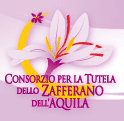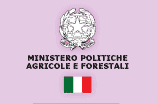

 Disciplinary
Production Areas
PDO Brand
Forms
Production and Processing
Working phases
The History of Saffron
Photogallery
Disciplinary
Production Areas
PDO Brand
Forms
Production and Processing
Working phases
The History of Saffron
Photogallery
According to Greek mythology
the birth of saffron is to be
attributed to the love of a
very handsome youth called
Crocus, who was protected
by the gods. He fell in love with
a sweet nymph called Smilax
who was the god Hermes’s
favourite. To avenge himself on
Crocus, the god transformed
the youth into the beautiful
saffron flower.
Saffron has been known for thousands of years, in fact Homer, Virgil and Pliny often mention it in their works as did Ovid in The Metamorphosis . It is mentioned in Egyptian scrolls dating from the II Century BC, in the Bible and in the IX and XII books of the Iliad. Isocrates used to have his pillows perfumed with saffron before going to bed and Trojan women used it to scent the fl oors of their temples. Saffron was cultivated in Cilicia, Barbary and Styria and Scono writes that the Sydonians and the Styrians used saffron to colour the veils of their brides and the priests to perfume their temples for important religious ceremonies.
From Asia the cultivation of saffron spread to various parts of the world, even as far as Tunisia, and from there to Spain, covering the regions of Albasete, Teruel, Toledo, Valencia and Murcia. From these areas it came to Italy brought by a Dominican monk belonging to the Santucci family of Navelli. The Synod of Toledo, held in about 1230 and approved by Pope Gregory IX, introduced the Inquisition. At that time the monk Santucci was a member of the Inquisition court. He was a great enthusiast of both the law and agriculture. Santucci was enraptured by the tiny saffron plant and,with the sweet soil of his homelands in Navelli in mind,believed that this plant would thrive there. This habitat did indeed turn out to be very favourable, it yielded a product which was far better than that cultivated in other countries.
The cultivation soon spread to the surrounding areas and the noble families of the recently founded town of L’Aquila (Notar Nanni, Ciolina, Bonanni, Signorini, etc.) soon started a fl ourishing trade with the cities of Milan and Venice.
The scientifi c name Crocus originates from the Greek Krokos, whereas the name Saffron is derived from the Arab Zafraan. Saffron (Crocus Sativus Linneo) is a very small plant, just 12 – 15 cms high. It is reproduced by vegetative propagation i.e. by transplanting the corms (bulbs) as the plant does not produce viable seeds and also the particular position of the reproductive organs (androecium and gynoecium) makes it a sterile triploid mutant with 2N=24 (Nathea 1977).
In the XIII Century the town of L’Aquila had recently been founded and yet was soon famous thanks to the excellent quality of its saffron. This boosted the economy based on sheep breeding and wool production. From the plateau of Navelli the cultivation spread to the whole province of L’Aquila, resulting in a fl ourishing trade. After a short time L’Aquila was to set up trading with the most important cities in Italy like Milan and Venice, as well as with foreign cities like Frankfurt, Marseille, Vienna, Nuremberg and Augsburg.
The ruling monarch, King Robert of Anjou (1317) abolished taxation on saffron to favour its trade. But soon afterwards L’Aquila clashed with the King who, not only re-enforced the taxation, but increased it to fi nance important public works like the new hospital and the Basilica of Saint Bernardino of Siena.
L’Aquila saffron became established internationally and was much sought after by many merchants. A certain Jobst Findenken from Nuremberg personally came to L’Aquila to buy saffron but he adulterated it with other types of saffron before selling it back home. He was soon exposed and on July 27th 1444 was burnt alive together with the product he was carrying. It was the Monday after Saint Jacob’s Day. His wife, instead, was exiled to the opposite bank of the Rhine. In 1513 the most important merchants from Nuremberg bought houses in L’Aquila and acquired citizenship. During their long stay in L’Aquila they purchased the entire production of saffron. They were: Tuder, Immoff, Wachter and Munzer.
The XV Century was the most important period in the history of L’Aquila, so much so that King Ferrante I of Aragon decreed the right of the town to found a University. This event coincided with the opening of a fl ourishing printing works by a saffron merchant and the laying of the foundation stone of the famous Basilica of Saint Bernardino. The Saint’s Mausoleum instead, was entirely fi nanced by Jacopo Notar Nanni from Civitaretenga, a great friend of Saint Bernardino’s and properous saffron and wool merchant thanks to his ability as a sheep breeder. The town of L’Aquila was often in dire straits, especially under Spanish rule, but, thanks to the saffron merchants who sold off their product, it was able to pay the taxes imposed.
With the accession of the Bourbons to the Kingdom of Naples the saffron farmers acquired new confi dence, so much so that in 1830 production reached 45 quintals from a surface area of 450 hectares. But in the XX Century cultivation started declining again, fi rst of all because of confl icts and then because of abuses by the merchants who did not want to pay a fair price for the saffron.
Saffron has been known for thousands of years, in fact Homer, Virgil and Pliny often mention it in their works as did Ovid in The Metamorphosis . It is mentioned in Egyptian scrolls dating from the II Century BC, in the Bible and in the IX and XII books of the Iliad. Isocrates used to have his pillows perfumed with saffron before going to bed and Trojan women used it to scent the fl oors of their temples. Saffron was cultivated in Cilicia, Barbary and Styria and Scono writes that the Sydonians and the Styrians used saffron to colour the veils of their brides and the priests to perfume their temples for important religious ceremonies.
From Asia the cultivation of saffron spread to various parts of the world, even as far as Tunisia, and from there to Spain, covering the regions of Albasete, Teruel, Toledo, Valencia and Murcia. From these areas it came to Italy brought by a Dominican monk belonging to the Santucci family of Navelli. The Synod of Toledo, held in about 1230 and approved by Pope Gregory IX, introduced the Inquisition. At that time the monk Santucci was a member of the Inquisition court. He was a great enthusiast of both the law and agriculture. Santucci was enraptured by the tiny saffron plant and,with the sweet soil of his homelands in Navelli in mind,believed that this plant would thrive there. This habitat did indeed turn out to be very favourable, it yielded a product which was far better than that cultivated in other countries.
The cultivation soon spread to the surrounding areas and the noble families of the recently founded town of L’Aquila (Notar Nanni, Ciolina, Bonanni, Signorini, etc.) soon started a fl ourishing trade with the cities of Milan and Venice.
The scientifi c name Crocus originates from the Greek Krokos, whereas the name Saffron is derived from the Arab Zafraan. Saffron (Crocus Sativus Linneo) is a very small plant, just 12 – 15 cms high. It is reproduced by vegetative propagation i.e. by transplanting the corms (bulbs) as the plant does not produce viable seeds and also the particular position of the reproductive organs (androecium and gynoecium) makes it a sterile triploid mutant with 2N=24 (Nathea 1977).
In the XIII Century the town of L’Aquila had recently been founded and yet was soon famous thanks to the excellent quality of its saffron. This boosted the economy based on sheep breeding and wool production. From the plateau of Navelli the cultivation spread to the whole province of L’Aquila, resulting in a fl ourishing trade. After a short time L’Aquila was to set up trading with the most important cities in Italy like Milan and Venice, as well as with foreign cities like Frankfurt, Marseille, Vienna, Nuremberg and Augsburg.
The ruling monarch, King Robert of Anjou (1317) abolished taxation on saffron to favour its trade. But soon afterwards L’Aquila clashed with the King who, not only re-enforced the taxation, but increased it to fi nance important public works like the new hospital and the Basilica of Saint Bernardino of Siena.
L’Aquila saffron became established internationally and was much sought after by many merchants. A certain Jobst Findenken from Nuremberg personally came to L’Aquila to buy saffron but he adulterated it with other types of saffron before selling it back home. He was soon exposed and on July 27th 1444 was burnt alive together with the product he was carrying. It was the Monday after Saint Jacob’s Day. His wife, instead, was exiled to the opposite bank of the Rhine. In 1513 the most important merchants from Nuremberg bought houses in L’Aquila and acquired citizenship. During their long stay in L’Aquila they purchased the entire production of saffron. They were: Tuder, Immoff, Wachter and Munzer.
The XV Century was the most important period in the history of L’Aquila, so much so that King Ferrante I of Aragon decreed the right of the town to found a University. This event coincided with the opening of a fl ourishing printing works by a saffron merchant and the laying of the foundation stone of the famous Basilica of Saint Bernardino. The Saint’s Mausoleum instead, was entirely fi nanced by Jacopo Notar Nanni from Civitaretenga, a great friend of Saint Bernardino’s and properous saffron and wool merchant thanks to his ability as a sheep breeder. The town of L’Aquila was often in dire straits, especially under Spanish rule, but, thanks to the saffron merchants who sold off their product, it was able to pay the taxes imposed.
With the accession of the Bourbons to the Kingdom of Naples the saffron farmers acquired new confi dence, so much so that in 1830 production reached 45 quintals from a surface area of 450 hectares. But in the XX Century cultivation started declining again, fi rst of all because of confl icts and then because of abuses by the merchants who did not want to pay a fair price for the saffron.


















